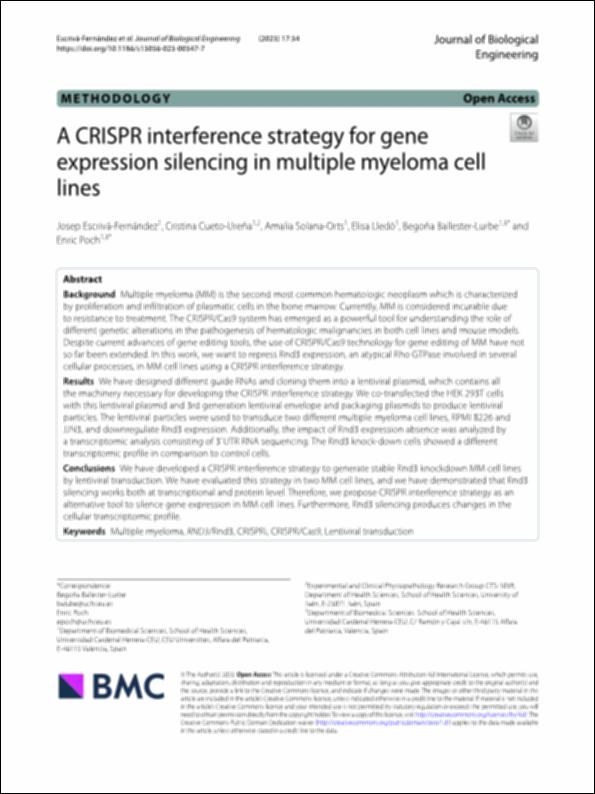Please use this identifier to cite or link to this item:
http://hdl.handle.net/10637/15507A CRISPR interference strategy for gene expression silencing in multiple myeloma cell lines
| Title: | A CRISPR interference strategy for gene expression silencing in multiple myeloma cell lines |
| Authors : | Escrivá Fernández, Josep Cueto Ureña, Cristina Solana Orts, Amalia Lledó Feijoó, Elisa Ballester Lurbe, Begoña Poch Jiménez, Enric |
| Keywords: | Médula ósea; Bone marrow; Tumors; Tumors; Tratamiento médico; Medical treatment; Célula; Cells |
| Publisher: | Springer Nature |
| Citation: | Escrivá-Fernández, J., Cueto-Ureña, C., Solana-Orts, A., Lledó, E., Ballester-Lurbe, B. & Poch, E. (2023). A CRISPR interference strategy for gene expression silencing in multiple myeloma cell lines. Journal of Biological Engineering, vol. 17, i. 1, art. 34. DOI: https://doi.org/10.1186/s13036-023-00347-7 |
| Abstract: | Background: Multiple myeloma (MM) is the second most common hematologic neoplasm which is characterized by proliferation and infiltration of plasmatic cells in the bone marrow. Currently, MM is considered incurable due to resistance to treatment. The CRISPR/Cas9 system has emerged as a powerful tool for understanding the role of different genetic alterations in the pathogenesis of hematologic malignancies in both cell lines and mouse models. Despite current advances of gene editing tools, the use of CRISPR/Cas9 technology for gene editing of MM have not so far been extended. In this work, we want to repress Rnd3 expression, an atypical Rho GTPase involved in several cellular processes, in MM cell lines using a CRISPR interference strategy. Results: We have designed different guide RNAs and cloning them into a lentiviral plasmid, which contains all the machinery necessary for developing the CRISPR interference strategy. We co-transfected the HEK 293T cells with this lentiviral plasmid and 3rd generation lentiviral envelope and packaging plasmids to produce lentiviral particles. The lentiviral particles were used to transduce two different multiple myeloma cell lines, RPMI 8226 and JJN3, and downregulate Rnd3 expression. Additionally, the impact of Rnd3 expression absence was analyzed by a transcriptomic analysis consisting of 3' UTR RNA sequencing. The Rnd3 knock-down cells showed a different transcriptomic profile in comparison to control cells. Conclusions: We have developed a CRISPR interference strategy to generate stable Rnd3 knockdown MM cell lines by lentiviral transduction. We have evaluated this strategy in two MM cell lines, and we have demonstrated that Rnd3 silencing works both at transcriptional and protein level. Therefore, we propose CRISPR interference strategy as an alternative tool to silence gene expression in MM cell lines. Furthermore, Rnd3 silencing produces changes in the cellular transcriptomic profile. |
| URI: | http://hdl.handle.net/10637/15507 |
| Rights : | http://creativecommons.org/licenses/by/4.0/deed.es Open Access |
| ISSN: | 1754-1611 (Electrónico) |
| Issue Date: | 4-May-2023 |
| Center : | Universidad Cardenal Herrera-CEU |
| Appears in Collections: | Dpto. Ciencias Biomédicas |
Items in DSpace are protected by copyright, with all rights reserved, unless otherwise indicated.


